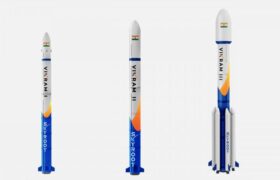On the occasion of the 100th anniversary of the birth of renowned Indian Rocket Scientist, Dr.Satish Dhawan, Skyroot Aerospace unveiled its first fully 3D printed cryogenic rocket engine, appropriately named Dhawan-1.
The engine is 100% 3D Printed and uses 100% Cryo Propellants (LNG/LoX). It is also 100% Made in India. The Indian space startup also demonstrated Vikram-2 upper stage tech. This is India’s first privately developed indigenous fully Cryogenic rocket engine, running on Liquid Natural Gas (LNG) as fuel.
Much like its counterparts in the US and – while trailing behind by a few years in Europe as well – Skyroot is building technologies for responsive, reliable and economic access to space. The firm envisions a future where spaceflight is as regular, reliable and affordable as air flight. Skyroot is founded by former engineers of the rocket design center of ISRO. Veterans from Indian Space and Defence programs who bring forth over three centuries of collective experience in building rocket systems.
Manufacturing on Demand
In order to do this Skyroot is building three classes of rockets. The Vikram I, II, and III. Vikram, named after Dr. Vikram Sarabhai, the father of the Indian Space Program, is a series of launch vehicles especially crafted for the small satellite market. Built on a common architecture and covering a wide range of payloads, they offer the most affordable and on-demand ride to space.
The Indian Space Research Organisation (ISRO) aims to harness space technology for national development while pursuing space science research & planetary exploration. ISRO built India’s first satellite, Aryabhata, which was launched by the Soviet Union on 19 April 1975. In 2017, ISRO launched one hundred and four satellites in a single rocket (PSLV-C37), a world record. ISRO launched its heaviest rocket, Geosynchronous Satellite Launch Vehicle-Mark III (GSLV-Mk III), also in 2017 and placed a communications satellite GSAT-19 in orbit. With this launch, ISRO became capable of launching 4-tonne heavy satellites into GTO. In 2019, ISRO launched its second lunar mission Chandrayaan-2 to study the lunar geology and the distribution of lunar water.
You might also like:
3DCeram and Design Bureau Ivchenko qualify SILICORE ceramic for investment casting: However, foundry cores with the complexity needed for efficient new generation turbine blades—which integrate internal cooling channels—are time consuming and expensive to make using traditional manufacturing processes such as ceramic injection molding, because they must be fabricated in several pieces and assembled. The lead times associated with traditional means have also meant that few modifications (with high cost impact) can be made to foundry core designs throughout the production process.



Leave A Comment